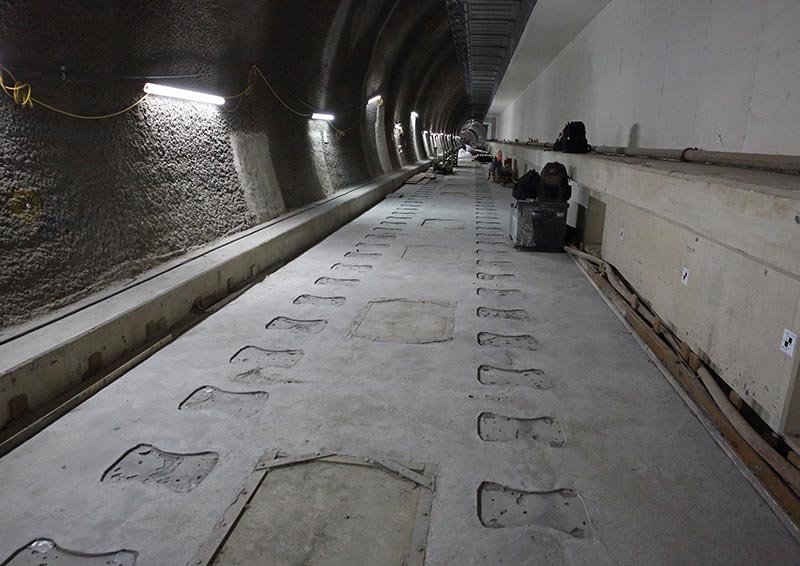High-density floating track slab
Can you pump heavyweight concrete through 500 m of 125 mm pipeline? Andrew Turner discusses the challenges of pumping heavyweight concrete for use in high-density floating track slab (FTS) at Crossrail.
In 2011, we were asked if Camfaud could pump heavyweight concrete through 500 m of 125 mm pipeline? Being honest, we said we didn't know and being foolhardy we added that we would give it a go.
That question was asked at the design stage of the Crossrail project when Arup was trying to solve the potential problem of noise and vibration being transferred from the track slab to the Barbican performing arts centre.
We gave it a go and to everyone’s delight and relief the concrete that went into the hopper of our Schwing concrete pump duly came out of the end of the pipeline into the test shutter.
Fast forward to 2015, and we were asked a very similar question. Can you pump heavyweight concrete through 900 m of 125 mm pipeline? This time we were a bit more confident in our reply: we think so and we’ll be more than happy to try.
The question this time came from the successful bidder for the Crossrail C610 contract, Alstom Transport, TSO and Costain, more commonly known as ATC JV.
Concrete pumping trials:
Before the FTS construction began we worked closely with Crossrail, ATC JV, London Concrete, who had won the contract to supply the concrete, and LKAB Minerals, supplier of the heavyweight aggregate.
After extensive laboratory and batching plant trials the material was put to the test in a series of three pumping trials. These were conducted through increasing pump line lengths: 130 m, 500 m and finally 900 m.
Each of the trial pours was a success with the equipment being equal to the task and the material holding together under pressure without segregating or settling out in the pipeline during delays in the pumping.
Also tested during the pumping trials was Camfaud’s water washout system. On the 900 m pumping trial the pipeline contained 11 m3 of heavyweight concrete weighing 40 tonnes. We aimed to use as much of this concrete in the pour to minimise waste, reducing environmental impact and also the overall cost of the contract. The water washout worked as planned and so was adopted into the pumping scheme.
The success of the trials brought us a contract for the project and so we set about augmenting our static pump fleet and putting together a crew of experienced operators and linesmen.
Concrete pumping at Crossrail:
We pumped the concrete into the track slab from three locations: Bond Street station, Fisher Street access shaft and Farringdon station.
Each of the pump set-ups was different due to the size and configuration of the pumping station. At each site we worked with the temporary works engineers to design the pumping station configuration and particularly to install and secure the high pressure concrete delivery line.
Each pumping station included the water washout system with a dedicated washout pump to push the line clear of material, most of it being used to finish the pour with only a small amount pumped to waste. The water was then blown back to recycling tanks on the surface, treated and used for the next cleaning cycle.
After the trials and the early pours our confidence grew that we would complete the contract even with a few pours at or around our previous record distance of 900 m.
Due to programme changes the operation at Bond Street was extended. This led to the question: can you pump heavyweight concrete through 1,000 m of 125 mm pipeline? Without hesitation, we replied: of course we can.
This article was originally published here by ICE on 13 Sept 2017. It was written by Andrew Turner, Area Manager, Camfaud Concrete Pumps.
--The Institution of Civil Engineers
[edit] Related articles on Designing Buildings Wiki
Featured articles and news
RTPI leader to become new CIOB Chief Executive Officer
Dr Victoria Hills MRTPI, FICE to take over after Caroline Gumble’s departure.
Social and affordable housing, a long term plan for delivery
The “Delivering a Decade of Renewal for Social and Affordable Housing” strategy sets out future path.
A change to adoptive architecture
Effects of global weather warming on architectural detailing, material choice and human interaction.
The proposed publicly owned and backed subsidiary of Homes England, to facilitate new homes.
How big is the problem and what can we do to mitigate the effects?
Overheating guidance and tools for building designers
A number of cool guides to help with the heat.
The UK's Modern Industrial Strategy: A 10 year plan
Previous consultation criticism, current key elements and general support with some persisting reservations.
Building Safety Regulator reforms
New roles, new staff and a new fast track service pave the way for a single construction regulator.
Architectural Technologist CPDs and Communications
CIAT CPD… and how you can do it!
Cooling centres and cool spaces
Managing extreme heat in cities by directing the public to places for heat stress relief and water sources.
Winter gardens: A brief history and warm variations
Extending the season with glass in different forms and terms.
Restoring Great Yarmouth's Winter Gardens
Transforming one of the least sustainable constructions imaginable.
Construction Skills Mission Board launch sector drive
Newly formed government and industry collaboration set strategy for recruiting an additional 100,000 construction workers a year.
New Architects Code comes into effect in September 2025
ARB Architects Code of Conduct and Practice available with ongoing consultation regarding guidance.
Welsh Skills Body (Medr) launches ambitious plan
The new skills body brings together funding and regulation of tertiary education and research for the devolved nation.
Paul Gandy FCIOB announced as next CIOB President
Former Tilbury Douglas CEO takes helm.
UK Infrastructure: A 10 Year Strategy. In brief with reactions
With the National Infrastructure and Service Transformation Authority (NISTA).
























